Accelerate IT operations with AI-driven Automation
Automation in IT operations enable agility, resilience, and operational excellence, paving the way for organizations to adapt swiftly to changing environments, deliver superior services, and achieve sustainable success in today's dynamic digital landscape.
Driving Innovation with Next-gen Application Management
Next-generation application management fueled by AIOps is revolutionizing how organizations monitor performance, modernize applications, and manage the entire application lifecycle.
AI-powered Analytics: Transforming Data into Actionable Insights
AIOps and analytics foster a culture of continuous improvement by providing organizations with actionable intelligence to optimize workflows, enhance service quality, and align IT operations with business goals.
It’s a harsh reality that over two-thirds of tech startups fail to deliver meaningful returns to investors. Why? Because turning a groundbreaking idea into a functional, successful software product is anything but straightforward.
Software development, especially custom-built solutions, is fraught with uncertainty. Whether it’s technical complexity, market misalignment, or unexpected integration challenges—risks are everywhere. And more often than not, these risks are underestimated or entirely overlooked in the early stages.
While around 80% of startups make it through their first year, the survival rate plummets when it comes to scaling technology projects. The larger and more ambitious the project, the higher the chance it’ll stumble due to unmet expectations, blown budgets, or unresolved feasibility issues.
So, how can you confidently move from concept to product without crashing halfway through development? The answer lies in a powerful, often overlooked phase of product development—the Proof of Concept (PoC).
In this blog post, we’ll break down what a PoC means in the context of software development, and why it’s crucial for reducing risk. From types and benefits to real-world examples and actionable steps, this is your complete guide to making your ideas bulletproof before writing thousands of lines of code.
A recent survey found that 48% of M&A professionals are now using AI in their due diligence processes, a substantial increase from just 20% in 2018, highlighting the growing recognition of AI’s potential to transform M&A practices.
What is PoC in Software Development?
A Proof of Concept (PoC) in software development is a small-scale project used to test whether a specific idea, functionality, or technology is viable in a real-world scenario. It’s not about creating a polished product but rather validating critical assumptions before investing significant time, money, and resources into full-scale development.
A PoC helps answer questions like:
- Will this idea work as intended?
- Can it be implemented within current constraints?
- What challenges might arise?
It’s a low-risk, high-reward step in the innovation process, offering clarity before diving into deeper waters.
Unlike a Minimum Viable Product (MVP) that seeks market validation with enough core features to attract early adopters, a PoC is more of an internal experiment focused on verifying specific assumptions.
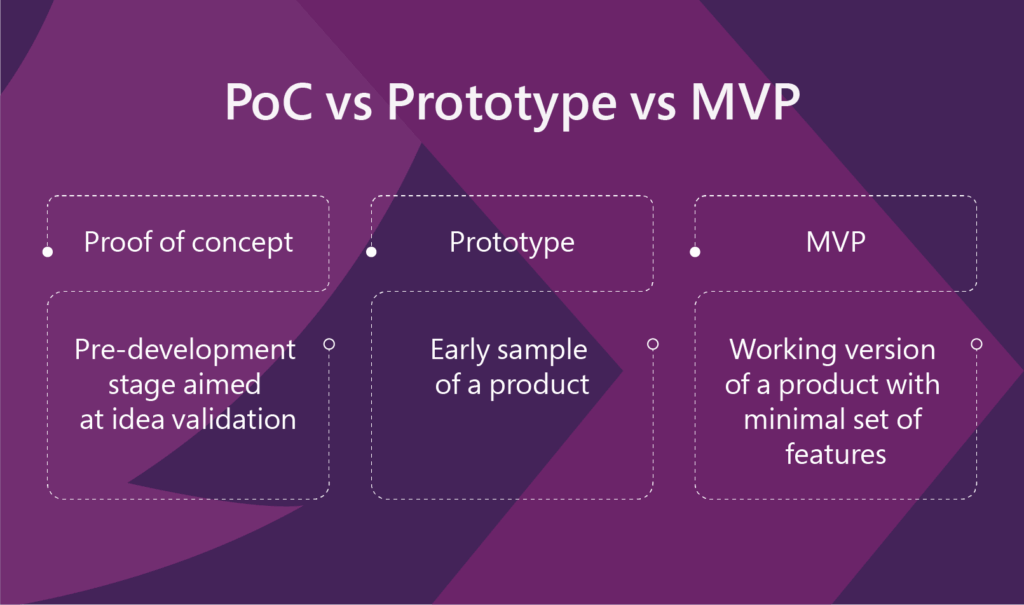
Where is PoC Used in Software?
Proofs of Concept are leveraged across many areas in the software industry. Some common use cases include:
- New Technology Adoption: When a company decides to incorporate blockchain, AI, or microservices into existing systems.
- Integration Projects: Testing the interoperability between legacy systems and new applications.
- Security Evaluations: Validating whether novel authentication or encryption methods can safeguard data without hindering performance.
- Performance Enhancements: Demonstrating that a new algorithm or architecture can handle increased loads or reduce processing time.
- Client Acquisition: Agencies may use PoCs to showcase potential software capabilities to prospective clients before signing large contracts.
Why PoC is Critical in Software Development
- Risk Mitigation
A primary reason to build a PoC is to identify and address technical and operational risks early on. By testing out critical components before committing significant resources, teams can uncover integration challenges, scalability issues, or unexpected performance problems in a controlled setting. - Resource Optimization
Developing a PoC allows companies to focus on the core functionalities that really matter. Instead of investing in full-scale development for an untested idea, organizations can use a PoC to filter out non-viable features. The projects which start with a PoC can save up to 25–30% of development costs, as resources are allocated more efficiently and wasted on features that do not meet the initial requirements are minimized. This focused approach not only saves time and budget but also accelerates decision-making and market entry. - Stakeholder Confidence
A tangible, working prototype makes it much easier to communicate the value of an idea to stakeholders. Investors, management, and even potential customers are more likely to buy into a concept when they see real progress rather than just theoretical models or sketches. In fact, surveys have shown that a working PoC can increase stakeholder investment readiness by as much as 40%. This boost in confidence can lead to easier access to further funding and an increased commitment from all involved parties, which is essential for long-term project success. - Innovation Catalyst
PoCs promote a culture of experimentation within development teams. They provide a low-stakes environment in which new ideas and cutting-edge technologies can be tested without the pressure of delivering a full-scale production system immediately. This experimental mindset not only fosters creative solutions but also accelerates learning curves and technical agility, helping companies stay competitive in rapidly evolving markets. - Feedback Loop
One of the most significant advantages of a PoC is the opportunity for early feedback. By releasing a prototype—even to a limited audience—developers and product managers can gather insights on usability, performance, and overall user satisfaction. The feedback obtained not only confirms what works but also highlights necessary adjustments, ensuring that the final product is robust and well-aligned with user needs.
The Benefits of Creating a PoC in Software Development
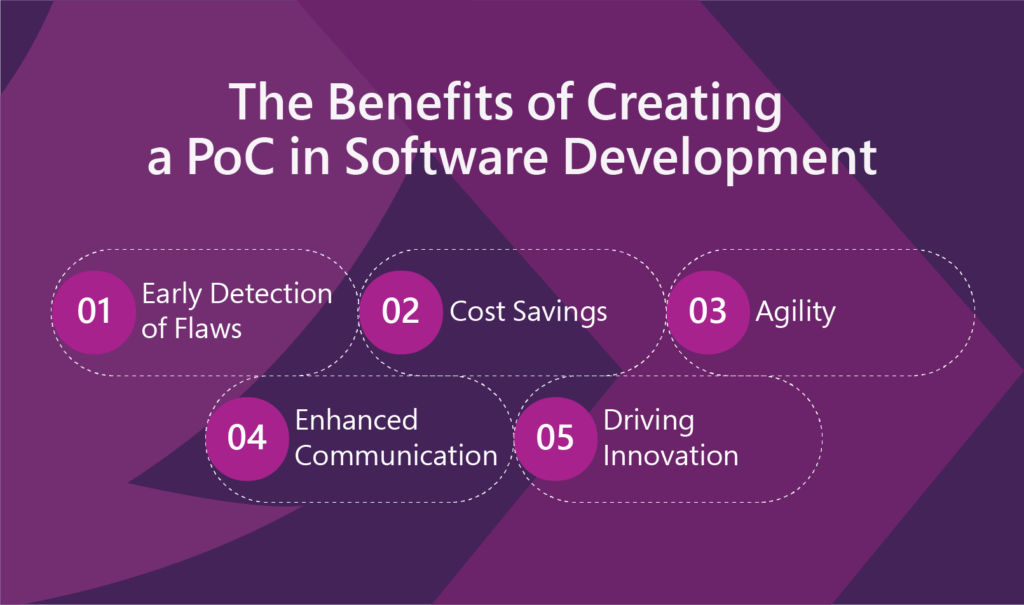
Early Detection of Flaws
Before committing to full-scale development, a PoC helps uncover technical constraints, architecture weaknesses, usability issues, or integration roadblocks. If you’re developing a chatbot, the PoC might reveal limitations in natural language understanding that would derail your timeline later if unnoticed.
Cost Savings
By identifying potential problems early, businesses can avoid costly reworks or scrapping projects midway. It’s far cheaper to fix an issue during PoC than after a launch. A fintech firm avoided spending $500,000 by realizing in PoC that their core data provider’s API wasn’t scalable.
Agility
POCs give teams the flexibility to test different approaches and pivot fast if something isn’t working. This promotes agility in decision-making and design. Startups often use POCs to validate ideas before seeking investment or full development, enabling them to move quickly and lean.
Enhanced Communication
A working PoC helps teams and stakeholders visualize the idea, ensuring alignment. It acts as a communication bridge between developers, product managers, and clients.
Stakeholder benefit: Instead of abstract requirements, stakeholders see a tangible demo, improving buy-in and reducing misunderstandings.
Driving Innovation
Since POCs encourage experimentation without the pressure of delivering a complete product, they promote innovation and risk-taking within safe bounds. Tech teams become more proactive in testing new tools, approaches, or architectures that might otherwise be dismissed.
6 Steps to Develop an Efficient PoC – The Process
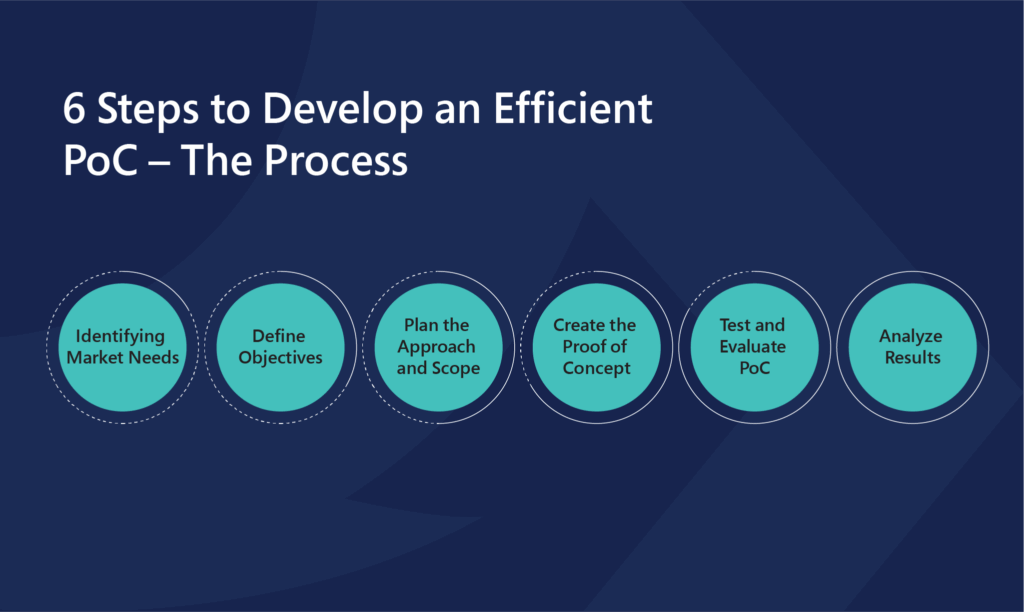
1. Identify the Need or Problem Statement
Purpose: Understand why you are building the PoC in the first place.
Every effective PoC starts with a clear identification of the problem you are trying to solve or the opportunity you are exploring. This step lays the foundation for the entire process.
Key actions:
- Define the pain point or business challenge.
- Identify the target users or stakeholders.
- Determine what success will look like from both technical and business perspectives.
For Instance, a logistics company is struggling with delivery delays. They want to test whether integrating AI-powered route optimization can reduce transit time. The PoC will aim to validate the technical integration of AI and its impact on delivery metrics.
2. Define Success Criteria and Objectives
Purpose: Clearly outline what outcomes must be achieved for the PoC to be considered a success.
Without measurable goals, a PoC becomes subjective and hard to evaluate. Success criteria can be technical (e.g., performance benchmarks) or business-focused (e.g., user engagement, cost savings).
Key actions:
- Define measurable metrics (KPIs) such as system uptime, load handling, speed, or accuracy.
- Align success metrics with stakeholder expectations.
- Create a simple checklist to measure performance post-PoC.
3. Plan the Approach and Scope
Purpose: Design a lean, manageable plan for the PoC with minimal overhead and maximal impact.
Planning involves choosing the right technologies, determining the scope (what to include and what to exclude), and allocating resources. The scope should be narrow enough to avoid feature creep but broad enough to test feasibility.
Key actions:
- Choose tools, tech stack, and platforms for the PoC.
- Decide what features or components to build (usually 1 or 2 core functions only).
- Set a timeline (typically 2–4 weeks).
- Allocate roles and responsibilities.
4. Build the PoC
Purpose: Develop the core functionality needed to validate your assumptions.
At this stage, you create a lightweight version of the software concept with just enough functionality to demonstrate feasibility. This is not a prototype or MVP—it’s a focused build to prove that the idea can work technically.
Key actions:
- Code the core feature(s) that address the main problem.
- Integrate any third-party APIs or tools if necessary.
- Avoid unnecessary design or UI work—focus on function, not form.
- Keep it modular and adaptable for future scaling or pivoting.
Document every step as you go. You’ll need this for both technical handoff and stakeholder presentations later.
5. Test and Evaluate the PoC
Purpose: Verify whether the PoC meets the success criteria you defined earlier.
Testing goes beyond basic QA. You want to know: Does it work? Is it scalable? Can it handle real-world scenarios?
Key actions:
- Conduct functional testing to ensure the PoC works as intended.
- Run performance and load tests if needed.
- Simulate real-world usage to test reliability and edge cases.
- Collect feedback from potential users or domain experts.
Metrics to evaluate:
- Execution time
- System compatibility
- Response under stress/load
- Technical debt discovered
If the PoC fails, it’s not a loss—it’s valuable insight that helps you pivot or refine your idea.
6. Analyze Results and Present Findings
Purpose: Decide the next steps—should you move forward, pivot, or shelve the idea?
Once testing is complete, assess the results against your predefined success metrics. A successful PoC isn’t just about proving the technology works—it’s about proving the idea is worth pursuing.
Key actions:
- Create a concise report summarizing objectives, process, results, and recommendations.
- Highlight what worked, what didn’t, and what needs improvement.
- Share findings with key stakeholders and leadership teams.
- Recommend whether to move to prototype/MVP phase, revise the concept, or stop the project.
Include both qualitative and quantitative data. Stakeholders love seeing metrics, but they also value user feedback, expert opinions, and team learnings.
Real – World Example: A forward-thinking ecommerce company decides to develop a Proof of Concept. They start by defining a problem – cart abandonment rates. The solution to this will be a more streamlined checkout process. The PoC involves creating a prototype with a simplified checkout flow, testing it with a select user group, and measuring success through increased conversion rates.
Common Mistakes in PoC for Software Development and How to Overcome Them
| Mistake | Solution |
|---|---|
| Trying to build a full product | Focus only on the core functionality |
| Poor documentation | Keep detailed notes and findings |
| Ignoring user feedback | Include early users where possible |
| Vague objectives | Define success metrics before starting |
| Skipping stakeholder involvement | Present interim progress and gather feedback |
When Should You Skip a PoC?
While PoCs are valuable, they aren’t always necessary. Here are scenarios where you can skip it:
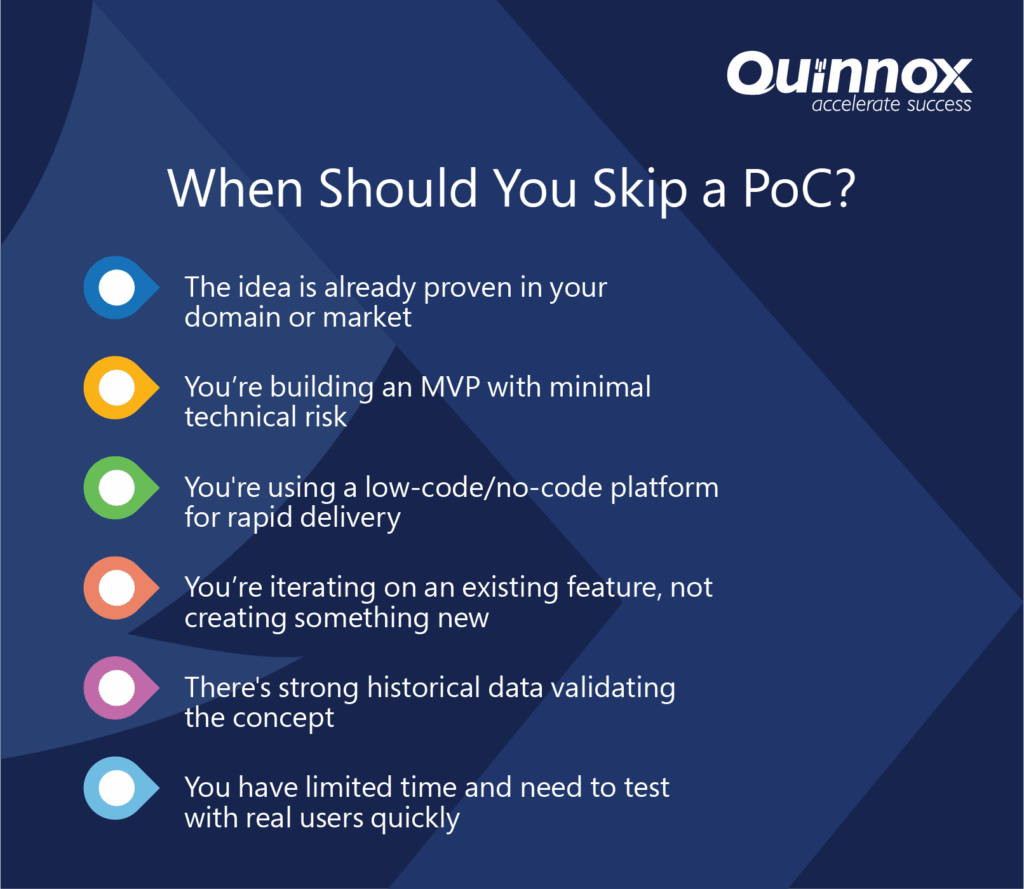
Final Thoughts
In a world where software innovation often walks a tightrope between brilliance and breakdown, a well-structured Proof of Concept acts as a safety net—and a springboard. It empowers organizations to validate feasibility, reduce development risk, win stakeholder trust, and accelerate time to market.
At Quinnox, we turn possibilities into proof with rapid, impactful Proof of Concepts. Backed by Quinnox AI (QAI) Studio—our AI innovation hub, helps you move from concept to confidence—faster. With tailored PoC prototypes, we evaluate feasibility, ensure data readiness, and validate business outcomes. Let us help your de-risk innovation and unlock AI’s full potential—before you scale.

With iAM, every application becomes a node within a larger, interconnected system. The “intelligent” part isn’t merely about using AI to automate processes but about leveraging data insights to understand, predict, and improve the entire ecosystem’s functionality.
Consider the practical applications:
In the Infinite Game of application management, you can’t rely on tools designed for finite goals. You need a platform that understands the ongoing nature of application management and compounds value over time. Qinfinite is that platform that has helped businesses achieve some great success numbers as listed below:
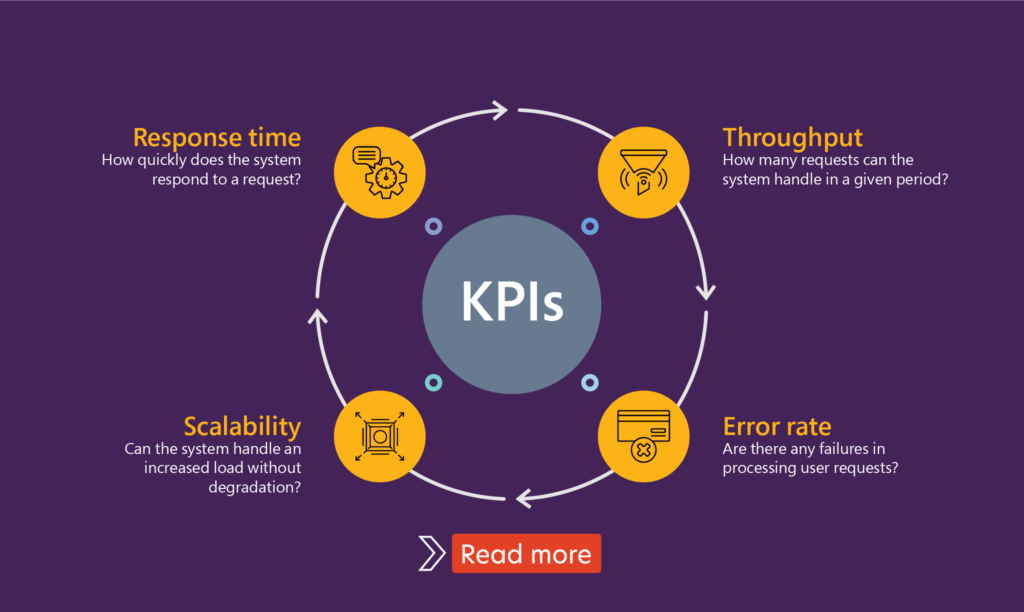
1. Auto Discovery and Topology Mapping:
Qinfinite’s Auto Discovery continuously scans and maps your entire enterprise IT landscape, building a real-time topology of systems, applications, and their dependencies across business and IT domains. This rich understanding of the environment is captured in a Knowledge Graph, which serves as the foundation for making sense of observability data by providing vital context about upstream and downstream impacts.
2. Deep Data Analysis for Actionable Insights:
Qinfinite’s Deep Data Analysis goes beyond simply aggregating observability data. Using sophisticated AI/ML algorithms, it analyzes metrics, logs, traces, and events to detect patterns, anomalies, and correlations. By correlating this telemetry data with the Knowledge Graph, Qinfinite provides actionable insights into how incidents affect not only individual systems but also business outcomes. For example, it can pinpoint how an issue in one microservice may ripple through to other systems or impact critical business services.
3. Intelligent Incident Management: Turning Insights into Actions:
Qinfinite’s Intelligent Incident Management takes observability a step further by converting these actionable insights into automated actions. Once Deep Data Analysis surfaces insights and potential root causes, the platform offers AI-driven recommendations for remediation. But it doesn’t stop there, Qinfinite can automate the entire remediation process. From restarting services to adjusting resource allocations or reconfiguring infrastructure, the platform acts on insights autonomously, reducing the need for manual intervention and significantly speeding up recovery times.
By automating routine incident responses, Qinfinite not only shortens Mean Time to Resolution (MTTR) but also frees up IT teams to focus on strategic tasks, moving from reactive firefighting to proactive system optimization.
Did you know? According to a report by Forrester, companies using cloud-based testing environments have reduced their testing costs by up to 45% while improving test coverage by 30%.
FAQ’s Related to PoC in Software Development
POC refers to Proof-of-Concept which is a prototype that validates the practicality and feasibility of a particular product or system. The core objective of POC is to show the concept, idea, and design of a software system and help investors, project managers, and stakeholders make well-informed decisions regarding software development.
A PoC (Proof of Concept) is built to validate technical feasibility.
A prototype demonstrates user experience or design flow.
An MVP (Minimum Viable Product) includes basic features to test market fit.
Typically, a PoC takes between 2 to 4 weeks, depending on complexity and scope. At Quinnox, we’ve accelerated this process using ready-to-use frameworks and automation tools.
Build a PoC when exploring:
New technology (AI, ML, blockchain)
System integration
Performance or scalability upgrades
Ideas with untested assumptions
Not necessarily. If the technology is well understood, risk is low, and the scope is straightforward, you may skip a PoC. But in high-risk, innovation-driven, or integration-heavy scenarios, a PoC is strongly recommended—and that’s where Quinnox comes in.
We work across sectors including banking and finance, retail, logistics, and manufacturing. Our industry-specific experience allows us to create tailored PoCs that align with compliance, legacy systems, and customer expectations.